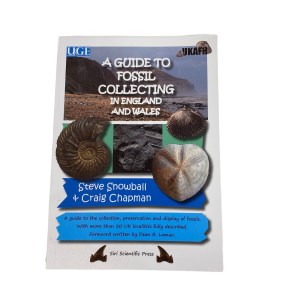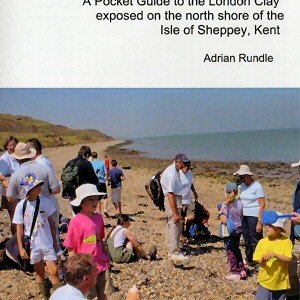Warden Point on the Isle of Sheppey is probably the most popular site for collecting London Clay fossils in the UK. This location is easily accessed, with lots of fresh fossils constantly being washed out. It is also famous for the wide variety of fossils, which can be found that includes everything from turtles, lobsters and crabs to sharks’ teeth, snakes, crocodiles, molluscs and plant remains.
DIRECTIONS
♦ Warden Point is located on the northern side of the Isle of Sheppey. The island is accessed from the A249 from the M2. Once over the main bridge to Sheppey, take the B2231 at the first roundabout. Continue along this road, going straight over at the next roundabout and right at the one after, which bypasses Eastchurch.
♦ Go straight over the following roundabout and keep going until you are near to Leysdown-on-Sea. Just before the sign for Leysdown, there is a road on the left. While a sign here says ‘Holiday Village’, the road will actually take you directly to Warden Point.
♦ Follow this until you reach a sharp bend, where there is a car park. Park here and walk northwest.
♦ Ref: 51.40953°N, 0.90807°E
PROFILE INFO
FIND FREQUENCY: ♦♦♦♦♦ – The coastline between Minster and Warden Point is extremely rich in fossils, with a very diverse range of species to be found. Several excellent publications have been written on London Clay fossils, with most of the documented finds occurring along this part of the coastline. Fossils can be found all year round and finding good specimens is not dependent on beach or tidal conditions.
CHILDREN: ♦♦♦♦♦ – While Warden Point is suitable for children, they need to be supervised at all times. The extensive foreshore can be very sticky and tides nearly always hit the base of the cliffs. There are also a number of sharp objects from shipwrecks along the beach, which could be dangerous for younger children.
ACCESS: ♦♦♦♦♦ – Warden Point is the most accessible site on the Isle of Sheppey. There is parking close by and it easy to find.
TYPE: – Although Warden Point has both very tall cliffs and an extensive foreshore, it is unlikely you will find many fossils in situ. Most fossils are washed out by the sea, like a giant sieve, and can be found in nodules and in the areas of shingle, exposed along the foreshore clay platforms. This site is also an SSSI, so digging in the cliff is not permitted under any circumstances.
FOSSIL HUNTING
Warden Point is an ideal location for families, but those wishing to visit should be aware that this part of the coastline along the northern side of the Isle of Sheppey can also be dangerous due to tides, deep mud and cliff falls. The clay can become extremely sticky and many have lost a boot or two and have had to walk back without them. Please read our safety notes (below) and be aware of these dangers.
The best way to find fossils is to get on one’s hands and knees, and search in the shingle exposed along the upper part of the beach. Fossils are generally found all year round, as they are constantly being washed out of the London Clay by the sea. The best time to collect is during the summer when the clay is much harder and accumulates more shingle. Whenever you visit, we recommend you visit two hours after high tide. Besides searching the shingle areas, larger fossils can generally be found either along the upper part of the beach after the sea has washed the cliffs or along the extensive foreshore. There are not normally any areas of shingle on the lower part of the foreshore. Instead, fossils here are mostly found in phosphatic nodules that run in bands along the foreshore. The best specimens are found in this way, but are not as common as the smaller fossils found by beach crawling higher up the beach.

GEOLOGY
The best way to find fossils is to get on one’s hands and knees, and search in the shingle exposed along the upper part of the beach. Fossils are generally found all year round, as they are constantly being washed out of the London Clay by the sea. The best time to collect is during the summer when the clay is much harder and accumulates more shingle. Whenever you visit, we recommend you visit two hours after high tide. Besides searching the shingle areas, larger fossils can generally be found either along the upper part of the beach after the sea has washed the cliffs or along the extensive foreshore. There are not normally any areas of shingle on the lower part of the foreshore. Instead, fossils here are mostly found in phosphatic nodules that run in bands along the foreshore. The best specimens are found in this way, but are not as common as the smaller fossils found by beach crawling higher up the beach.


SAFETY
Common sense should be used at all locations and prior knowledge of tides times is essential. It is very easy to get cut off by the tide, which often reaches the base of the cliffs. The cliff landslips are also very dangerous and should never be climbed – it is possible to get stuck in the clay. Care must also be taken on the foreshore, as this too can be very muddy and it is easy to become stuck. In addition, there can be a lot of sharp metal objects on the beach. Therefore, the coastline from Warden Point to Minster can be extremely dangerous. However, if you keep away from the cliff face, double check tide times and keep an eye on what you are stepping on, it is a safe place to collect.
EQUIPMENT
The fossils from Warden Point are found on the foreshore, so it is best to take a trowel and a knife. Indeed, a long handled trowel comes in very useful for picking up nodules and fossils, reducing the need to constantly bend down to inspect objects.
ACCESS RIGHTS
This site is a site of special scientific interest (SSSI). This means you can visit the site, but hammering the bedrock is not permitted. For full information about the reasons for the status of the site and restrictions, download the PDF from Natural England.
It is important to follow our ‘Code of Conduct’ when collecting fossils or visiting any site. Please also read our ‘Terms and Conditions‘
LINKS
♦ Buy Fossils, Crystals, Tools
♦ Location Discussions
♦ Deposits Magazine
♦ Join Fossil Hunts
♦ UK Fossils Network
-
A guide to fossil collecting in England and Wales
Original price was: £20.00.£16.00Current price is: £16.00. -
A Pocket Guide to the London Clay Exposed on the North Shore of the Isle of Sheppey, Kent: No. 1 (Rockwatch Guide)
Original price was: £4.00.£3.20Current price is: £3.20.






























